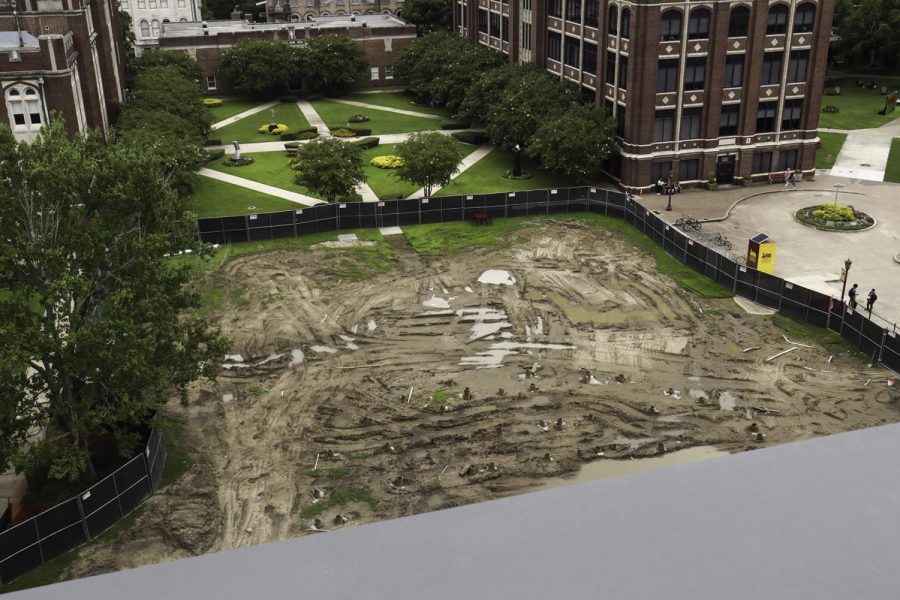Building Chapel of St. Ignatius sparks student concerns
The construction site for the Chapel of St. Ignatius sits barren and muddy on Monday August 22, 2022. Students see the site as an eyesore in the heart of Loyola’s campus.
September 1, 2022
In the summer of 2022, after a decade of anticipation, Loyola University New Orleans began construction on its new Chapel of St. Ignatius and Gayle and Tom Benson Jesuit Center, according to Patricia Murret, Loyola’s associate director of public affairs.
However, despite the university anticipating the chapel’s construction, students on campus have raised concerns surrounding the construction project as well as the purpose of the center itself.
According to Jose Unanue, a sophomore at Loyola majoring in business, it feels like the construction going on is a distraction for classes that surround it.
“I’ve been having a hard time concentrating in classes recently, especially since most of my classes are in Monroe Hall, which is directly in front of the construction site,” Unanue said, adding “there are a lot of other buildings that need to be fixed and repaired.”
Tom Ryan, newly interim vice president for mission and identity, responded by saying that the university is working on both building the chapel and repairing other buildings on campus. He also compared this construction project to the construction which previously occurred to build Monroe Hall.
“It was messy and inconvenient. But for me, looking at Monroe Hall now, what a gift that is”, Ryan said. He added that he believes that the new chapel and Benson center will be a similarly impactful gift by offering a peaceful place for spiritual healing, as well as additional classrooms. The new building will also contain gathering spaces, aside from the chapel, which students can use, according to Murret.
Myranda Cook, a junior at Loyola majoring in studio art and English writing, said she feels horrible about the project because it creates a disruptive environment.
“I don’t understand why Loyola didn’t start the construction as soon as we got out of school last semester. I understand it will take a long time, but even that little head start could’ve made a difference,” Cook said.
Murret clarified that this past summer was the first time that construction could actually start, given the COVID-19 pandemic, Hurricane Ida, and ongoing economic and supply difficulties in the country as a whole. Further, the university purposefully broke ground before classes started, Murret said, to limit disruptions as much as they could.
The university defended building the chapel by saying that it won’t change much of the university’s open space. There is plenty of open space available on campus, including the Res Quad, Palm Court, Peace Quad, and Academic Quad, the university said.
According to Murret, the construction site, which sits in the middle of Loyola’s main campus, occupies a larger space than the completed building will to accommodate the equipment and to allow safety measures.
“The reality is that the building itself will be a much smaller building that’s going to be in the northeast corner of the quad, and it’s going to preserve the majority of the green space,” Murret said.
Cook also expressed concerns over the project’s source of funding. Cook understood that Loyola did not have the greatest influence on how to use the Benson donation but suggested they could have declined it.
According to Murret, the chapel is entirely donor funded, which means that no funds from tuition and fees are being used for the construction. Ryan further clarified that the funding received for the chapel could not be used for other projects.
Cook also said she finds it difficult to wrap her head around how Loyola accepted money from the Benson family, saying that many students are concerned about the family as a donor.
According to Murret, this project is one of the most successful fundraising campaigns in Loyola’s history.
Murret said that the chapel will be “open to people of all faiths and will be designed to be an open welcoming gathering space.” She said that the center is going to be a “dedicated space for student activities.”
She also said that the school “wants a campus that ‘speaks’ our faith to a new generation, not only with words, but with structures and spaces.”








